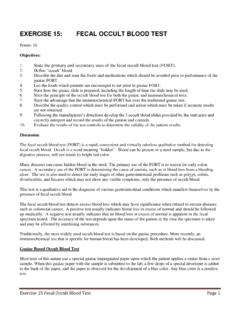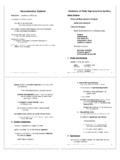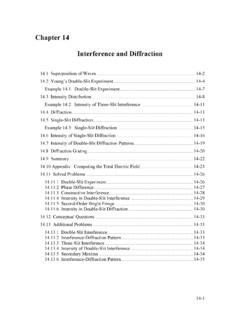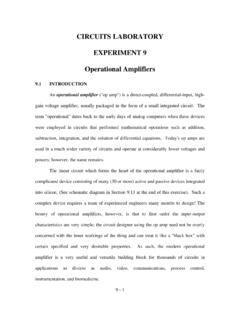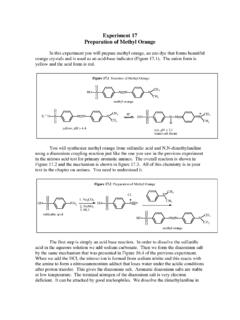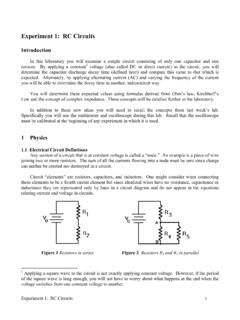Transcription of PHYS 2426 Engineering Physics II EXPERIMENT 5 CAPACITOR ...
1 05 - Cap Charge-Discharge - 1 - PHYS 2426 Engineering Physics II EXPERIMENT 5 CAPACITOR CHARGING AND DISCHARGING I. OBJECTIVE: The objective of this EXPERIMENT is the study of charging and discharging of a CAPACITOR by measuring the potential difference (voltage) across the CAPACITOR as a function of time. From this measurement the student will use the Logger Pro software to calculate the charge and the current as functions of time. The student will also measure the experimental time constant and use it to determine the experimental value of the capacitance of the CAPACITOR .
2 II. APPARATUS: Pasco AC/DC Electronics Lab CAPACITOR , about 1000 F Lab Pro Interface Batteries, volt D-cell, two (2) Computer with Logger Pro Ohmmeter (DMM) Vernier Differential Voltage Sensor Connecting wires Resistor (decade box) III. THEORY: A CAPACITOR consists of two conducting objects (plates) separated by a non-conducting medium (dielectric). The capacitance of a CAPACITOR is defined as the ratio of the charge on the one of the conductors to the potential difference between them, C = Q/V (1) When a CAPACITOR is connected to a power supply (battery), it begins to charge up.
3 During this process, both the charge Q and the potential difference, V, are increasing while the electric current is decreasing. This will continue until both Q and V reach their maximum values and the electric current goes to zero indicating that the charging process has stopped. The characteristic time that indicates how fast or slow a CAPACITOR charges or discharges is called the time constant. It is the time it takes the potential difference (or the charge) to To Differential Voltage Sensor RED BLACK 05 - Cap Charge-Discharge - 2 - increase from zero to (or ) of its maximum value.
4 The time constant TC depends on the values of the capacitance and the resistance in the circuit and is given by the equation TC = RC (2) A CAPACITOR needs a time period equal to 5 time constants to charge up to (or ) of maximum value. When this happens, we can assume for practical purposes that the CAPACITOR is fully charged. Further analysis shows (see your favorite Physics textbook) that the potential difference increases with time according to VC(t) = E (1 - exp(-t/RC)) (3) where E is the battery Emf. The charge increases similarly since Q(t) = CVC(t).
5 During the discharging process, both the charge and the potential difference decrease with time until they reach zero. IV. EXPERIMENTAL PROCEDURE: 1. Record the nominal value of the capacitance, written on the CAPACITOR , in your data table. 2. Choose a value for R to give a time constant value of RC = 2 sec. This is the nominal value of the time constant, T. Dial in the value of R on the decade resistance box and use the ohmmeter to measure it. Record this experimental resistance value in your data table. 3. Wire the circuit as shown in the figure above.
6 A. Make sure the CAPACITOR is completely discharged. b. Clip the Differential Voltage Probe to the CAPACITOR observing the correct polarity (RED lead to positive, BLACK lead to negative). c. Plug the other end of the cable into Analog Channel 1 in the LabPro interface. d. Next, follow the procedure described below on how to use Logger Pro to collect data for the CAPACITOR charging and discharging. The only data collected are the CAPACITOR potential difference, VC and the battery Emf, E. We will use Logger Pro to calculate the charge, the electric current and the time constant using this potential difference data.
7 The computer and the LabPro should be on. If they are not, turn them on. To Differential Voltage Sensor RED BLACK 05 - Cap Charge-Discharge - 3 - 4. Double click on the Logger Pro icon a. The application should automatically display 2 data columns for Time and Potential and a graph of Potential vs Time. b. A box in the lower left hand corner should display the current value of the voltage being measured by the Differential Voltage Sensor. This should be just about zero because the CAPACITOR has been discharged at this point.
8 5. Measure the battery Emf a. Open the circuit prior to measuring the battery Emf. The circuit should not be connected to either point a or point b. b. Observing the correct polarity, use the Differential Voltage sensor to measure the battery Emf, E. Record the value in your data table. c. By using the Differential Voltage Sensor to measure the CAPACITOR voltage difference, VC and the battery Emf, E we can avoid the calibration issue in the voltage measurements. The reason for this is that only the ratio of VC/E will be used to determine the experimental value of the time constant and hence the value of C.
9 V. DATA COLLECTION 1. Collect the CHARGING Data a. Click on COLLECT button and connect your switch wire to the circuit point "a". b. The CAPACITOR will start to charge and you will see the CAPACITOR potential difference increase. c. Practice this timing process to ensure that the CAPACITOR starts charging during the first 1 or 2 seconds after pressing the COLLECT button. 2. Collect the DISCHARGING Data a. When the time reaches 12 seconds (about 6 time constants) move your switch wire to the point in the circuit designated as "b".
10 B. The CAPACITOR starts to discharge and the CAPACITOR potential difference decreases to zero over the next 12 seconds. c. The potential difference vs. time data is stored in a data table and will be used to calculate the charge, the current and the time constant. 3. Constructing the New Data Columns The first step in creating a new column is to go to Data on the main menu, click on New Calculated Column. a. The first column will contain the ELECTRIC CHARGE data. 1. Click on options and call the new column Charge (Q) and give it units.


